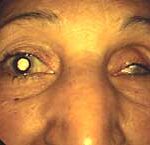Ophthalmic angiography is an essential diagnostic technique used to visualize the retinal and choroidal vasculature in vivo. This non-invasive or minimally invasive imaging procedure plays a pivotal role in the diagnosis, monitoring, and management of a wide range of ocular diseases, especially those involving the retinal and choroidal circulation.
It provides high-resolution images that help identify pathological changes such as vascular leakage, non-perfusion, neovascularization, and pigment epithelial detachment—conditions that are otherwise difficult to detect with standard fundoscopic examination.

Types of Ophthalmic Angiography
1. Fluorescein Angiography (FA)
Fluorescein angiography involves the intravenous injection of sodium fluorescein dye and sequential capturing of fundus photographs to track dye movement through the retinal vasculature.
Key Features:
- Visualizes retinal circulation only
- Used in diagnosing diabetic retinopathy, retinal vein occlusion, macular edema, retinal vasculitis
- Detects microaneurysms, leakage, capillary dropout, neovascularization
2. Indocyanine Green Angiography (ICGA)
Indocyanine green dye, which binds to plasma proteins and fluoresces in the near-infrared spectrum, allows deeper penetration to visualize choroidal circulation.
Key Features:
- Ideal for identifying choroidal neovascular membranes
- Crucial in evaluating polypoidal choroidal vasculopathy (PCV), central serous chorioretinopathy (CSCR), and uveitis
- Superior to FA for patients with media opacities or pigmented fundi
3. Optical Coherence Tomography Angiography (OCTA)
OCTA is a non-dye-based, non-invasive technique that uses motion contrast to detect blood flow in the retinal and choroidal microvasculature.
Key Features:
- High-resolution, 3D images
- Layer-by-layer vascular mapping
- Enables monitoring of age-related macular degeneration (AMD), diabetic maculopathy, glaucoma-related perfusion loss
Procedure and Technique
Patient Preparation
- Pupil dilation is typically required for FA and ICGA
- Medical history screening for dye allergies, renal function, and pregnancy
- Informed consent due to risk of mild side effects (e.g., nausea, dizziness)
Step-by-Step Overview
- FA/ICGA: Images taken at specific time intervals—early arterial phase, arteriovenous phase, venous phase, and late leakage phase
- OCTA: Utilizes decorrelation signals to generate angiograms without contrast injection
Indications for Ophthalmic Angiography
Ophthalmic angiography is indispensable in the management of several ocular pathologies. It aids in early diagnosis and guides timely intervention.
Retinal Vascular Disorders
- Diabetic retinopathy
- Branch and central retinal vein occlusion
- Retinal arterial occlusion
- Retinal vasculitis
Macular Diseases
- Macular edema
- Age-related macular degeneration (AMD)
- Cystoid macular edema
Choroidal Disorders
- Polypoidal choroidal vasculopathy
- Choroidal neovascularization
- Central serous chorioretinopathy
Ocular Tumors
- Choroidal melanoma
- Retinal hemangioblastoma
- Retinal capillary hemangioma
Advantages and Limitations
Advantages
- Precise mapping of vascular abnormalities
- Early detection of ischemia or neovascularization
- Dynamic imaging over time
- Guides laser and anti-VEGF therapy
Limitations
- Invasive (FA, ICGA involve IV dye)
- Risk of allergic reaction (mild to rare anaphylaxis)
- Not suitable for all patients (renal impairment, pregnancy)
- Cannot image through dense media opacities (except ICGA)
Safety and Side Effects
While generally safe, fluorescein and indocyanine green angiography can cause mild side effects:
- Nausea, vomiting
- Transient yellow skin discoloration or urine
- Allergic reactions
- Rare anaphylactic responses
OCTA, being dye-free, is the safest but limited in imaging deeper choroidal vessels.
Interpretation and Clinical Decision Making
Analyzing angiographic images requires knowledge of vascular anatomy and pathological changes. Findings such as:
- Leakage suggests inflammation or neovascularization
- Blockage or hypofluorescence suggests ischemia, hemorrhage, or pigment
- Window defects indicate RPE atrophy
These help ophthalmologists determine:
- The need for anti-VEGF therapy
- Indications for laser photocoagulation
- Monitoring disease progression or recurrence
Future Directions and Technological Advancements
Technological evolution continues to refine ophthalmic angiography. Modern advancements include:
- Wide-field angiography: Captures peripheral retina in a single frame
- Ultra-high-resolution OCTA
- Artificial intelligence (AI) for automated image analysis and diagnosis
Integration of multimodal imaging is becoming standard, combining FA, ICGA, and OCTA for comprehensive retinal and choroidal assessment.
Frequently Asked Questions:
Q1: Is ophthalmic angiography painful?
The procedure is generally painless, though the IV injection may cause brief discomfort.
Q2: How long does the angiography take?
It usually takes 10–30 minutes, depending on the type and number of images required.
Q3: Can ophthalmic angiography detect diabetic retinopathy early?
Yes. FA is especially effective at revealing microvascular changes before they are visible on fundoscopy.
Q4: Is dye-based angiography safe for pregnant women?
Fluorescein and ICG are generally avoided during pregnancy unless absolutely necessary.
Q5: What is the role of OCTA compared to FA and ICGA?
OCTA provides detailed, dye-free images of superficial and deep vascular layers but cannot show leakage or dynamic flow.
Ophthalmic angiography remains a cornerstone in modern ophthalmic diagnostics. Its role in uncovering intricate vascular changes of the retina and choroid makes it invaluable in both clinical and surgical decision-making. As imaging technologies evolve, combining traditional dye-based methods with OCTA and AI will lead to earlier detection, personalized treatments, and improved visual outcomes for millions worldwide.

